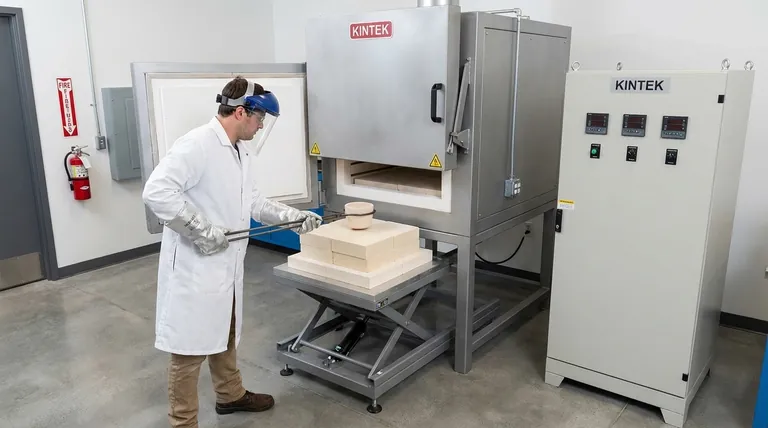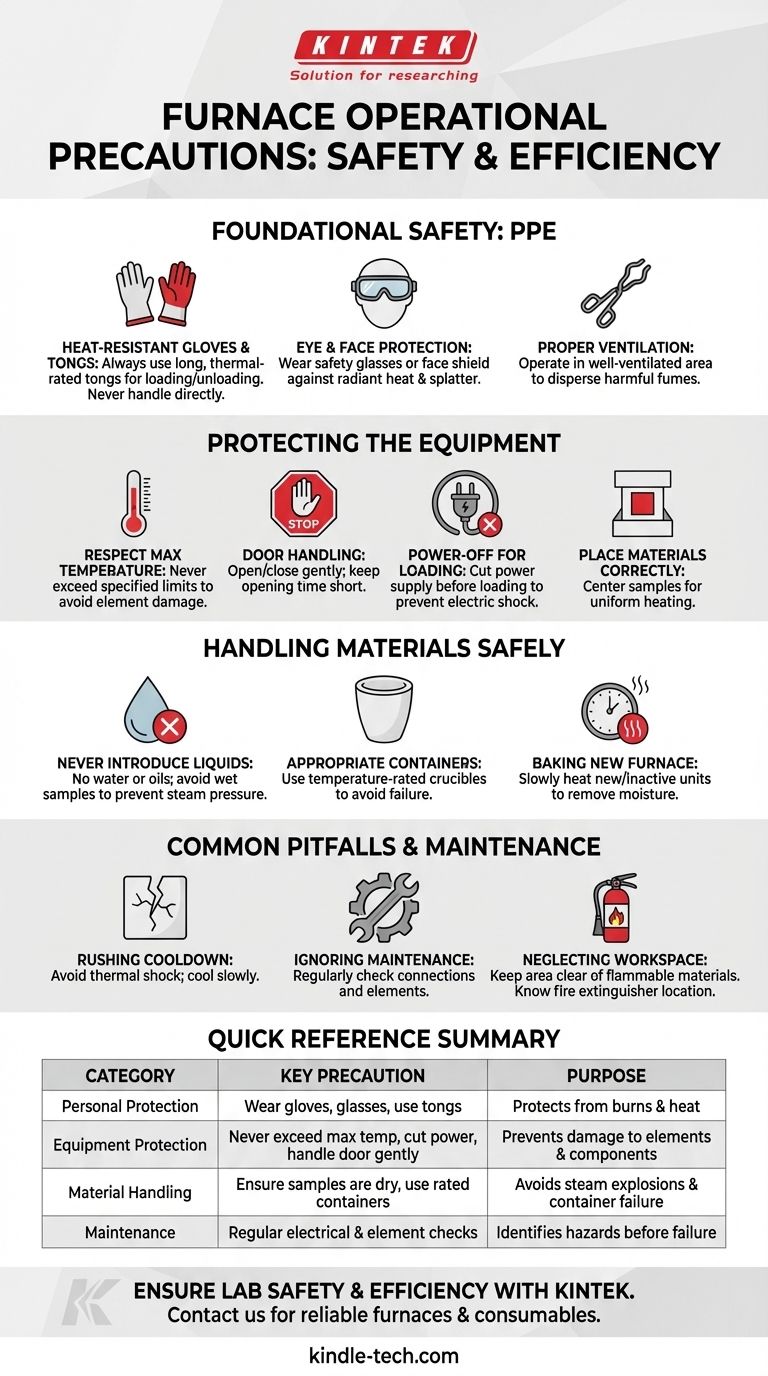The fundamental precautions for furnace operation center on protecting both the operator and the equipment from extreme heat and electrical hazards. This involves consistently using appropriate personal protective equipment (PPE), handling materials correctly with tongs, never exceeding the furnace's temperature limits, and cutting off power when loading or unloading samples to prevent electric shock.
Furnace safety is not a single action but a comprehensive system. It requires a combination of personal diligence with PPE, strict adherence to operational procedures, and regular equipment maintenance to prevent personal injury and ensure the furnace's longevity.

Foundational Safety: Personal Protective Equipment (PPE)
Your first line of defense is always proper personal protective equipment. The intense heat and potential for unexpected reactions demand respect.
Heat-Resistant Gloves and Tongs
You must always wear heat-resistant gloves when working near the furnace. Never handle items directly.
Use long, thermal-rated tongs or forceps to place and remove all items from the furnace chamber. This maintains a safe distance and protects you from severe burns.
Eye and Face Protection
Always wear safety glasses or a face shield. This protects your eyes from intense radiant heat and any potential splatter from superheated materials.
Proper Ventilation
Ensure the furnace is operated in a well-ventilated area. Some materials can release harmful fumes or off-gas when heated, and proper airflow is critical to disperse them safely.
Protecting the Equipment: Core Operational Rules
Preventing damage to the furnace is just as important as personal safety. Mishandling the equipment can lead to costly repairs and dangerous failures.
Respect the Maximum Temperature
Never operate the furnace above its specified maximum temperature. Doing so can damage the heating elements (like silicon carbide rods) and the internal insulation, leading to inaccurate performance and eventual failure.
Careful Handling of the Furnace Door
Open and close the furnace door gently and deliberately. Slamming it can damage sensitive components and the door seal.
Keep the door's opening time as short as possible to maintain thermal stability inside the chamber and reduce your exposure to heat.
Power-Off Procedures for Loading
Always cut off the power supply before loading or retrieving samples. This is a non-negotiable step to prevent the risk of severe electric shock.
Place Materials Correctly
Position your samples neatly in the center of the furnace. This ensures the most uniform heating and prevents potential damage from contact with the chamber walls or heating elements.
Handling Materials and Samples Safely
The state of your materials can introduce significant risk. What you put into the furnace directly impacts the safety and success of the operation.
Never Introduce Liquids, Water, or Oils
Do not, under any circumstances, pour liquids into the furnace chamber.
Furthermore, avoid placing samples that are wet or have residual water and oil on them. The rapid heating will cause the liquid to turn to steam, which can create a dangerous pressure buildup or even a small-scale explosion.
Use Appropriate Containers
Ensure any crucible or container you use is rated for your target temperature. Using an inappropriate container can cause it to crack, melt, or fail inside the furnace, ruining your sample and potentially damaging the equipment.
"Baking" a New or Unused Furnace
If a furnace is being used for the first time or after a long period of inactivity, it must be "baked." This involves heating it slowly over several hours to safely drive out any accumulated moisture from the insulation, which could otherwise cause damage.
Common Pitfalls and How to Avoid Them
Even experienced operators can make mistakes. Being aware of common pitfalls is crucial for maintaining a safe environment.
Rushing the Cooldown
Do not attempt to cool the furnace rapidly. Abrupt temperature changes can cause thermal shock, cracking both your sample and the furnace's internal ceramic components. Allow the furnace to cool down according to its specified procedure.
Ignoring Maintenance Checks
Periodically inspect the furnace. Check for the tightness of electrical connections and the condition of heating elements. A loose connection can create a fire hazard, and a failing element can break unexpectedly.
Neglecting the Workspace
Keep the area around the furnace clear of flammable materials and clutter. Always know the location of the nearest fire extinguisher and be familiar with emergency shutdown procedures.
Making the Right Choice for Your Goal
Your operational focus will shift depending on your immediate task.
- If your primary focus is routine daily operation: Make consistent use of PPE and strict adherence to power-off procedures for loading your absolute top priorities.
- If you are using a furnace for the first time or after long storage: Always perform a slow "baking" or drying cycle to safely remove trapped moisture before proceeding to high temperatures.
- If your primary focus is material integrity: Place samples precisely in the center for uniform heating and avoid rapid temperature changes during heating and cooling to prevent thermal shock.
By internalizing these precautions, you transform a potentially hazardous device into a safe, reliable, and powerful tool for your work.
Summary Table:
| Safety Category | Key Precaution | Purpose |
|---|---|---|
| Personal Protection | Always wear heat-resistant gloves, safety glasses, and use long tongs. | Protects operator from severe burns and radiant heat. |
| Equipment Protection | Never exceed max temperature, cut power when loading, and handle the door gently. | Prevents damage to heating elements and internal components. |
| Material Handling | Ensure samples are dry and use temperature-rated containers. | Avoids dangerous steam explosions and container failure. |
| Maintenance | Perform regular checks on electrical connections and heating elements. | Identifies potential hazards like loose wires before they cause failure. |
Ensure your laboratory operates with maximum safety and efficiency. KINTEK specializes in providing reliable lab furnaces and the essential consumables needed for safe operation. Our experts can help you select the right equipment and provide guidance on best practices. Contact our team today to discuss your specific furnace requirements and how we can support your lab's success.
Visual Guide

Related Products
- Laboratory Muffle Oven Furnace Bottom Lifting Muffle Furnace
- 1700℃ Muffle Oven Furnace for Laboratory
- 1800℃ Muffle Oven Furnace for Laboratory
- 1400℃ Muffle Oven Furnace for Laboratory
- 1400℃ Laboratory Quartz Tube Furnace with Alumina Tube Tubular Furnace
People Also Ask
- What is the burnout cycle on a furnace? Stop This Destructive Overheating Pattern Now
- What affects the melting point of a substance? Uncover the Key Factors & Forces
- Does melting point ever change? Unlock the Secrets of Pressure and Purity
- What is the difference between a crucible and a furnace? Understanding the Heat Source and Container Partnership
- Do different liquids melt at different rates? Unlock the Science of Melting Points and Material Properties



















